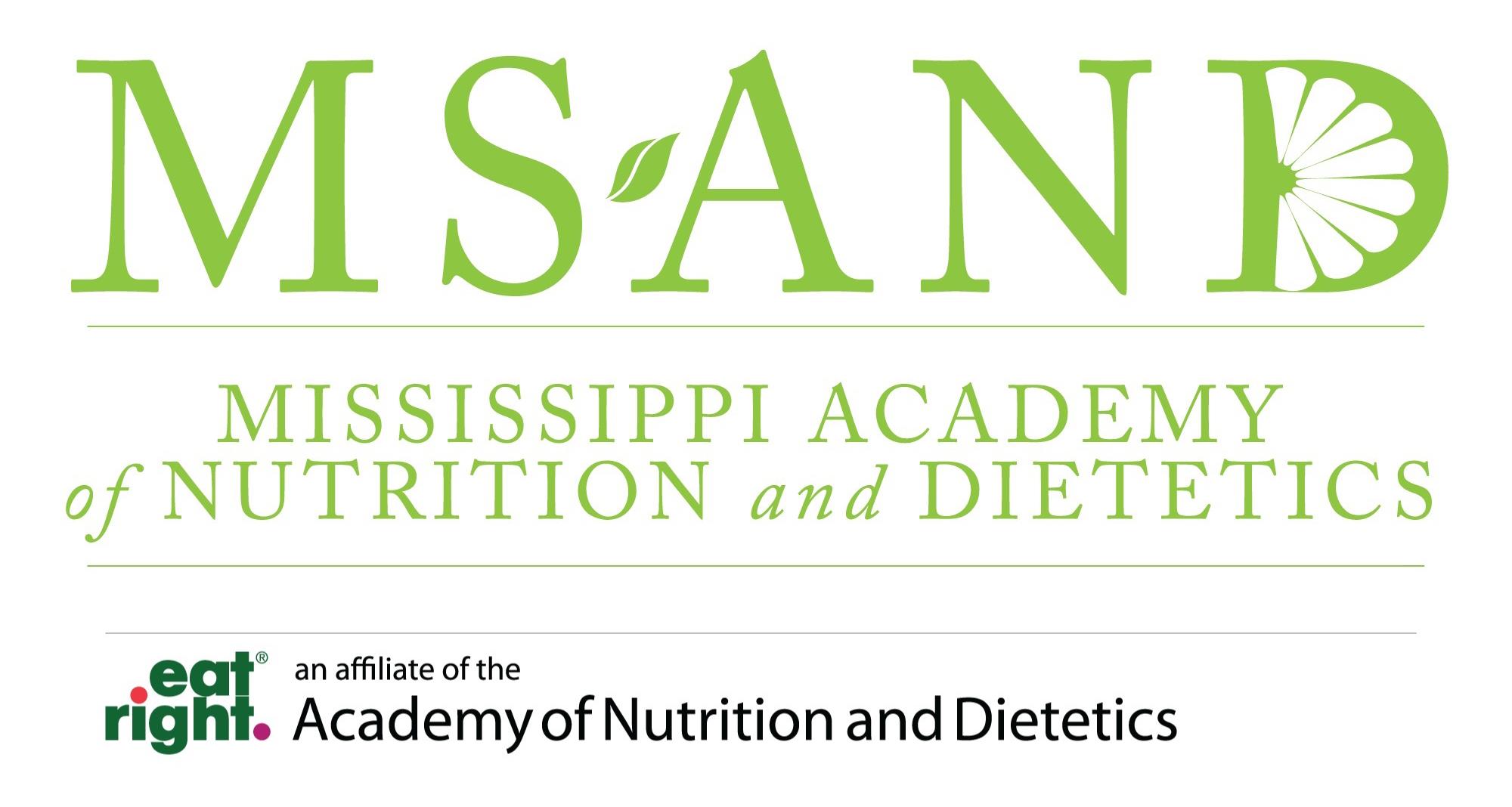
President’s Message
 Success. This word might mean many different things to different people but this word now has special meaning to me after the past few months on the roller coaster ride of the planning of the 2020 MS-AND Spring Conference. After the 2019 conference had ended and I had time to catch my breath, I said to myself “next year we’re going to go even bigger and better”. I envisioned a meeting where there was standing room only and all of Mississippi’s Dietitians gathered together in mass to learn and celebrate our profession. Little did I know at the time that we would be faced with combating a global pandemic, causing everyone to adjust their personal and professional lives, leaving us to be unable to assemble and make that prediction a reality.
Success. This word might mean many different things to different people but this word now has special meaning to me after the past few months on the roller coaster ride of the planning of the 2020 MS-AND Spring Conference. After the 2019 conference had ended and I had time to catch my breath, I said to myself “next year we’re going to go even bigger and better”. I envisioned a meeting where there was standing room only and all of Mississippi’s Dietitians gathered together in mass to learn and celebrate our profession. Little did I know at the time that we would be faced with combating a global pandemic, causing everyone to adjust their personal and professional lives, leaving us to be unable to assemble and make that prediction a reality.
This year’s chairperson, Heather White, and our Executive Director Assistant Rachel Whitlock, deserve a special note of congratulations for the work that they put into taking our meeting “virtual” in such a short amount of time. From the many emails, texts and phone calls that I have received since the conference wrapped, I think its safe to say that my prophecy was fulfilled and the 2020 MS-AND Spring Conference was a SUCCESS!
Thank you Heather and Rachel, as well as the many volunteers that put so much effort into bringing such a wonderful conference to life and thank you to everyone who participated!
MS-AND 2020 Annual Conference
The FIRST Mississippi Academy of Nutrition and Dietetics (MS-AND) virtual meeting was OUTSTANDING. It was hard for us to cancel the in-person meeting in March, but we rallied (as we always do) and pulled together a GREAT virtual conference. It was great to “see” so many of you with us last week! We’ve had some great feedback from many of you about the topics, presenters and the virtual platform. We are looking forward to possibly hold more meeting via Webex in the future. For those of you who attended, you will receive a link to the CEU Certificate and Conference evaluation soon. The theme of this year’s conference was Blueprint for Success where we learned about Ethics in Social Media, Advocacy, Food Culture, Motivational Interviewing, plus more. We regret that we couldn’t record the sessions on such a short time frame for the conference.
Thank you to all that participated!
We want to thank this year’s conference sponsors:





And a very special Thank You for the support of our Platinum Sponsors:
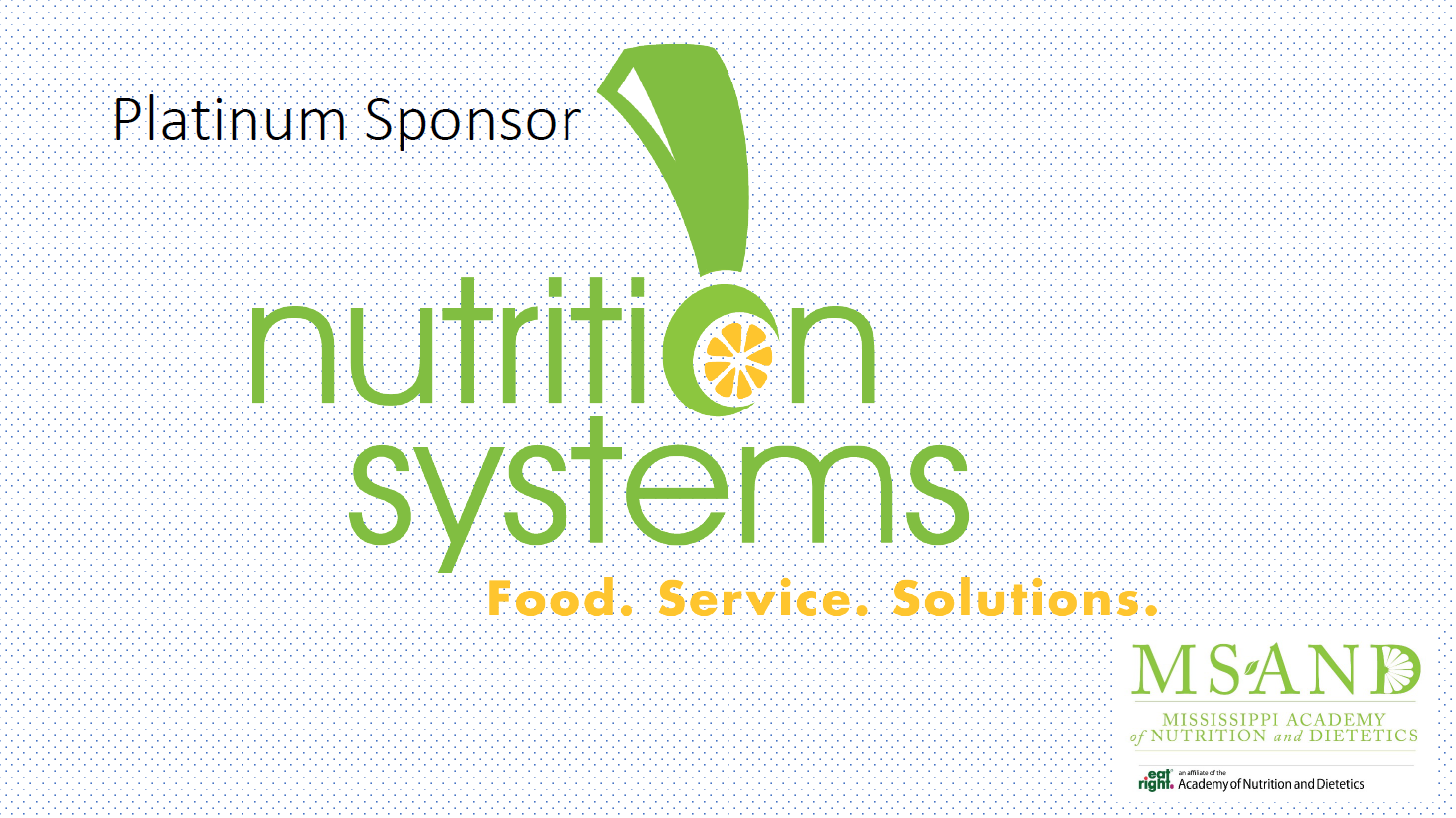
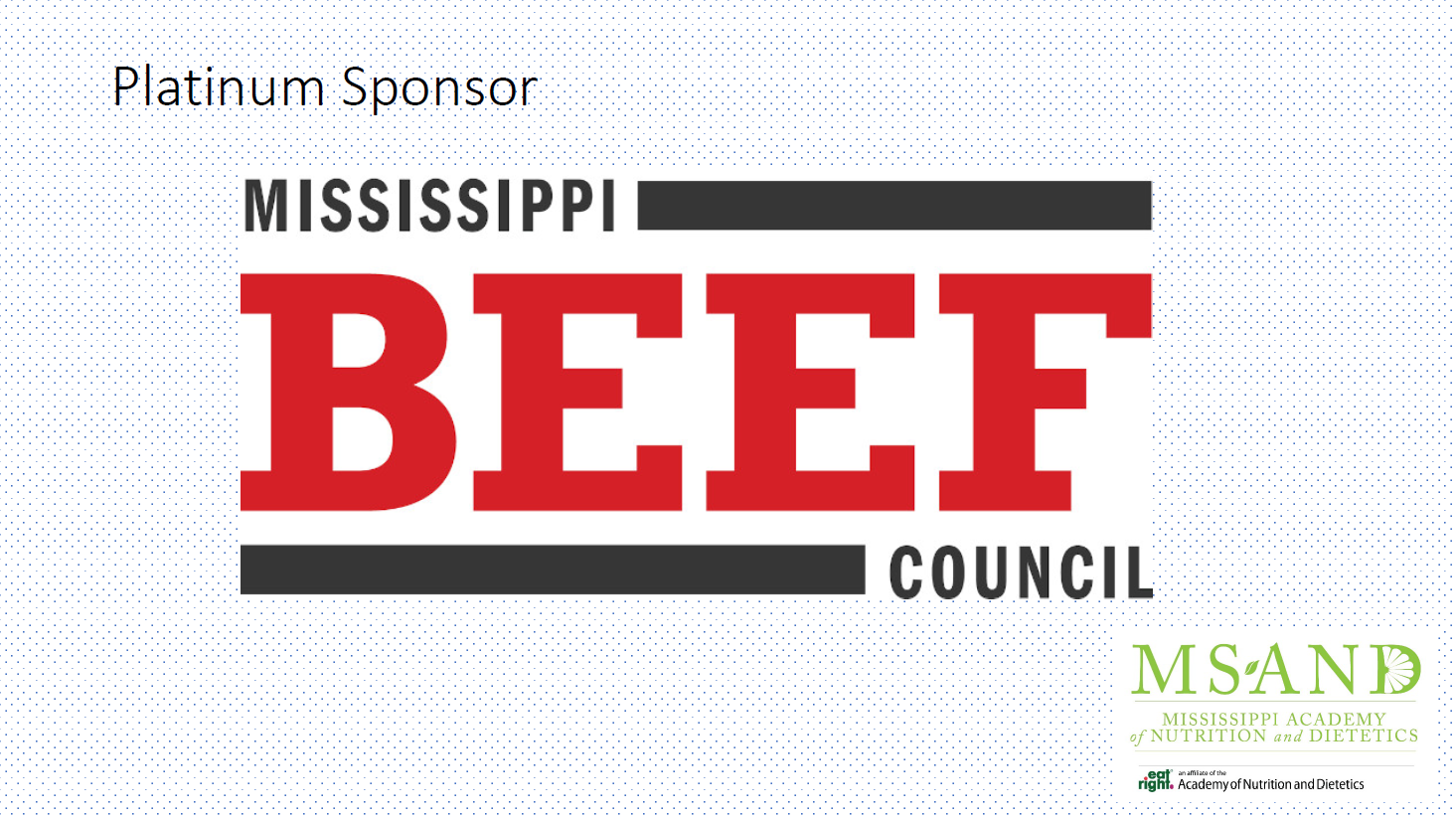
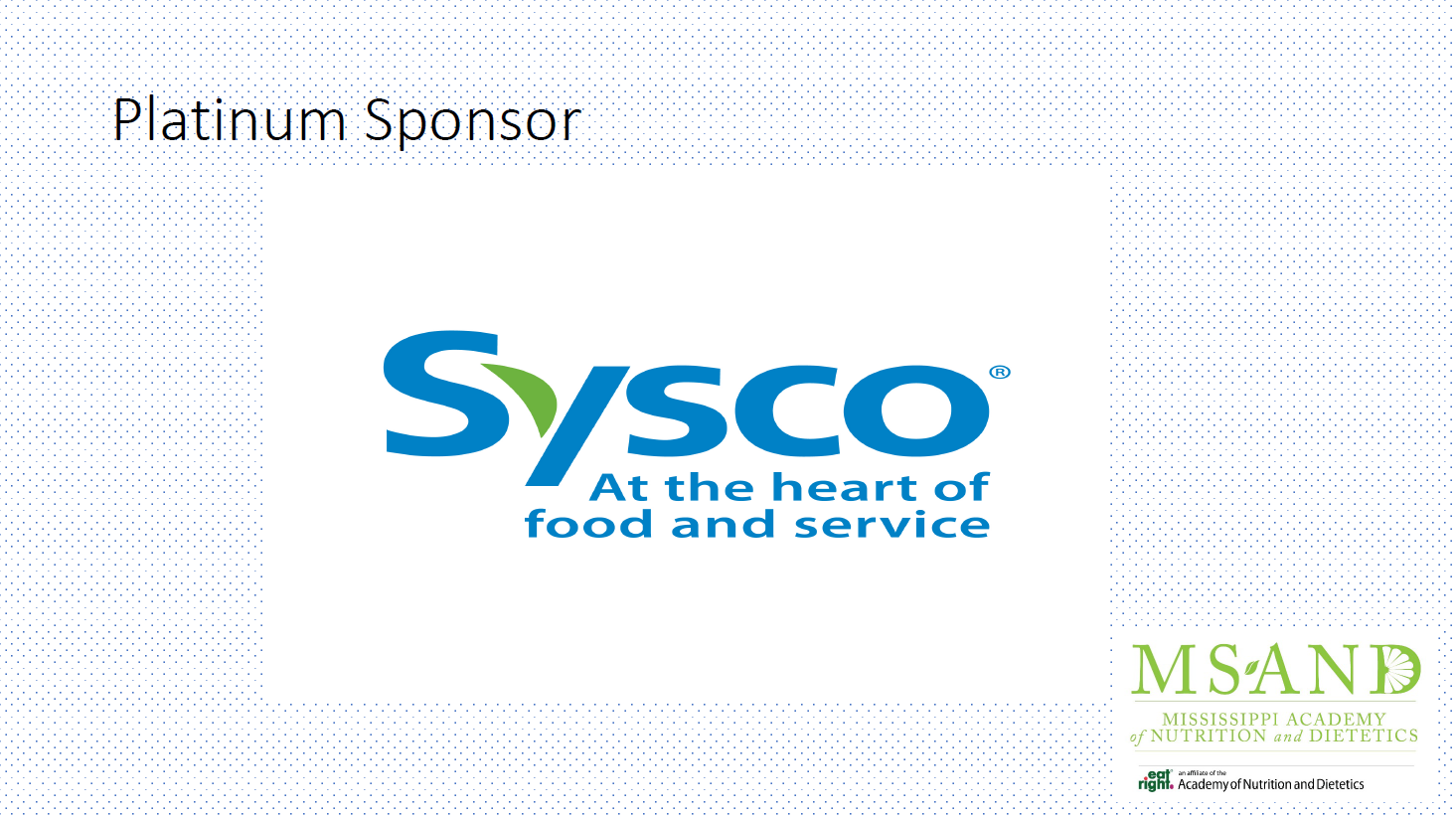

Abstract Spotlights
There is so much great nutrition research going on around Mississippi and we want share it with all our members! We are printing the abstracts that were originally accepted as poster presentations at the in-person meeting. Thank you to all the researchers who submitted and keep up your excellent work!
Title: “I ate my green baseballs today!” Mississippi Head Start Centers Score a Home Run with Hip Hop to Health, Jr.
Authors: Holly Huye, PhD, RD and LaShaundrea Bradford, MS, RD
According to the National Center for Health Statistics, obesity rates for young children aged 2 to 5 in 2015-2016 were 13.9%. Furthermore, Mississippi children have higher than the national average prevalence rates of obesity. The Impact of a Preschool Obesity Prevention (I-POP!) intervention used the evidence-based obesity prevention curriculum Hip Hop to Health, Jr. (HH2H) to promote healthy dietary and physical activity behaviors among Mississippi Head Start children. Summative focus groups with intervention teachers (N=20) across three Head Start centers were conducted to explore teachers’ attitudes toward the HH2H curriculum. The curriculum consists of eight weekly nutrition lessons, interactive activities with puppets, taste tests, and physical activity set to music. Focus group discussions were audio-recorded, transcribed, and analyzed for themes according to patterns in the data. Three themes emerged: Fun, Interactive Curriculum; Center-wide Benefits; and Child Enthusiasm for Healthy Foods. Teachers expressed how they enjoyed using the interactive materials and how the puppets added visual focus to reinforce key messages. Children enjoyed the puppets and music and looked forward to “I-POP” day. Not only did teachers indicate the health benefits for the children, but they also realized how the curriculum helped themselves to eat healthier and exercise. Even the kitchen staff started to provide healthier snacks. Lastly, the children were excited about their new-found knowledge about Go & Grow foods and their discovery of liking and eating vegetables. HH2H is a culturally and linguistically appropriate curriculum for children ages 3 to 5 that can address the obesity concerns in Mississippi.
Title: Psychological factors that predispose young adults to anorexia nervosa, bulimia nervosa, and binge eating disorders
Authors: Madison H. Christian1, Diane K. Tidwell2, Rahel Mathews3, Terezie Tolar-Peterson4
ABSTRACT
Introduction: In the United States, thirty million people suffer from an eating disorder. This study examined the extent to which psychological factors predispose young adults to eating disorders.
Methodology: Study participants (N = 103) were male and female college aged students (18-27 years old) from Mississippi State University (MSU). Measures included the Contour Drawing Rating Scale (CDRS), the Diet History Questionnaire III (DHQ III), the Eating Attitudes Test-26 (EAT-26), and the Rosenberg Self Esteem Scale. Data collected was analyzed using the Mann-Whitey U test and Pearson correlations.
Results: The CDRS observed a relationship between body perception and energy intake. The DHQ III revealed that discrepancies existed between recommended and actual calorie intakes among participants. The CDRS and energy intake had a significant negative relationship (P < 0.05). As respondents perceived themselves as having a larger body size, they reported consuming fewer calories. Seventeen participants (16.5%) that completed the EAT-26 were identified as being at risk for an eating disorder. The Rosenberg Self-Esteem Scale found that thirteen participants (12.6%) had low self-esteem.
Conclusion: This study determined that there are significant psychological predispositions that are important to consider when diagnosing and treating individuals with eating disorders in order to promote best practices. Findings from MSU students were compared to current evidence and provided a basis for the development of future studies.
Title: Assessment of Rapid Weight Loss Factors in Mixed Martial Arts: A Pilot Study
Author(s): Halfacre, K., MS, ISAK-1; Knight, K., PhD, LD; Valliant, M.W., PhD, RD, LD, CSSD; Joung, D., PhD; and Bass, M.A., PhD
RESEARCH OBJECTIVE: The purpose of this research was to investigate hydration, nutrition, supplementation, and body composition in relation to performance among Mixed Martial Arts (MMA) athletes practicing rapid weight loss (RWL).
BACKGROUND: MMA athletes practice intentional dehydration and limit nutritional intake to achieve RWL, a practice with health and performance risks.
METHODS: A sample of 10 male MMA athletes practicing RWL were invited to participate during a week of competition. Seven-day food/activity journals were collected. Urine specific gravity (USG) and body mass were assessed at baseline, weigh-ins, and endpoint. Body composition and punch velocity were assessed at baseline and endpoint. Demographics, fight result, and self-rated performance data were also collected.
STATISTICAL ANALYSIS: Descriptive statistics and Pearson correlations were estimated (IBM SPSS 26).
RESULTS: Nine MMA athletes (90%) completed the study. Eight participants (88.9%) were dehydrated at weigh-ins, with one participant (11.1%) failing to achieve euhydration prior to competition. Most participants (n=8, 88.9%) fasted (M=31.1 hours, SD=23.3 hours). Mean baseline-to-endpoint changes in body mass (-1.78%), body-fat percentage (-0.39%), fat-free-mass percentage (0.39%), and punching velocity (-1.322 mph) were assessed. Punching velocity was negatively correlated with fasting duration (r=-0.698, p<.05). Self-rated performance was positively correlated with punching velocity (r=0.676, p<.05) and negatively correlated with endpoint USG (r=-0.678, p<.05).
CONCLUSIONS: Fasting duration was negatively correlated with changes in punching velocity. Additionally, lower USG on the day of competition and improved punching velocity were correlated with better self-reported performance. Expanded analysis of RWL factors and their impact on the MMA athlete population may be warranted.
Title: Comparison of Three Different Temperature Measurement Devices Among Difficult to Measure Foods in Child Nutrition Programs
Authors: Emily M. Knight and Brent J. Fountain, PhD, RDN
Abstract: According to the US Department of Agriculture (2015), the only reliable method for ensuring the food safety of TCS (time-temperature control for safety) foods is to measure the internal endpoint temperature. Feng and Bruhn (2019) found that foodservice workers lacked knowledge related to selecting, sanitizing, calibrating, and utilizing a food thermometer. As a result, temperature control and risk of foodborne illness remain a concern for child nutrition programs. The purpose of this study was to compare the accuracy of the bimetallic-stemmed and infrared thermometers to the more accurate thermocouple thermometer. A second purpose was to identify best practices for measuring the internal temperature of select menu items from the Mississippi Recipes for Success 2019. Recipes were selected based on the risk of foodborne illness and the difficulty of obtaining accurate internal temperature due to shape and thickness. Data were collected on eight different recipes at five schools in a Mississippi public school district. While both the infrared and bimetallic thermometers yielded average temperatures below that of the thermocouple thermometer, observed temperatures were commonly above the recommended endpoint temperature for safe service. Since infrared thermometers measure the surface temperature, they may not be a reliable indicator of internal temperature. Bimetallic thermometers remain most common in foodservice due to low cost and ability to measure internal temperature. Techniques such as stacking and thermometer location can improve the accuracy of a bimetallic thermometer and appearance of food at service. In conclusion, child nutrition operations can benefit from standardizing measurement techniques and staff training.
Title: Connecting Mississippi Families to Community Health Resources
Authors: Madison Payne, RDN,LDN, Sylvia Byrd, PhD,RDN,LDN, Laura Downey,PhD, Tia Gregory
Partnerships are vital for community nutrition programs nationwide.
For Mississippi State University Extension (MSU-E) SNAP-Ed and EFNEP, community partners are invaluable for increasing participant reach, sharing information, bringing stakeholders together in innovative ways and serving target populations. MSU-E partnered with the Public Health Institute and Racial and Ethnic Approaches to Community Health (REACH) program with a common goal to reach limited resource pregnant women and families.
Agents in one Extension Region created over 80 connections with health leaders through REACH. Program Evaluation and Reporting System data showed 10 successful partnerships in less than one calendar year. Partners included hospitals, Baby Café’s, food banks, health clinics, and civic organizations. MSU-E and agency partnerships resulted in symbiotic cross-referrals and program promotion. Inter-agency promotion included word of mouth, social media, e-blasts, and brochures to an estimated 400 people within 3 months. In addition to increasing MSU-E program reach, agencies helped recruit and provided space for direct education programs.
An example of the shared referral process is pregnant mothers were recruited from hospital groups (Baby Café) to attend an MSU-E expectant mother’s course (Today’s Mom) hosted at the WIC office or partnering hospital and United Healthcare Community provided a guest speaker for one class. MSU-E also referred participants to prenatal classes, food banks, women’s resource centers, and other programs.
Community nutrition agencies can engage with stakeholders through communication to identify leaders with similar goals and develop strong partnerships. The MSU-E and REACH partnership is being maintained, bringing resources and programs to the public.
Title: Cooking Matters for Adults is Helping Mississippi Families Eat Healthier
Authors: Willcutt, Samantha, Gregory, Tia, Byrd, Sylvia
In Mississippi, the number of children living in poverty is high with 76 % persistent child poverty counties. It has been reported 21% of Mississippi’s adults consume vegetables less than one time per day. Mississippi State University Extension (MSU-E) partnered with Share Our Strength’s Cooking Matters to combat childhood hunger by teaching limited resource parents and caregivers how to shop for and prepare healthier meals. Extension Agents and Nutrition Educators are trained online and in-person. The hands-on training, led by a Chef, provides guidance and practice for teaching knife and food preparation skills. Cooking Matters for Adults (CMA) course participants engage in a variety of topics including nutrition, food resource management, and food safety while working together to prepare healthy, low-cost recipes. Since implementing CMA in March of 2018, 280 adults have enrolled in the course and 246 graduated (88%). CMA participants complete pre and post surveys that include behavioral questions addressing food choices and confidence preparing healthy food. Of the program participants who graduated, 91% reported an increase in healthy food preparation and 85% reported an increase in how often they eat fruit, vegetables, whole grains, or low-fat dairy. The interactive, hands-on CMA course helps families prepare and consume healthier foods. MSU-E continues to implement CMA in Mississippi.
Title: Developing a Social Marketing Campaign: HappyHealthy
Authors: Kelli Whitten, Byrd, Sylvia, Downey, Laura
The Supplemental Nutrition Assistance Program – Education (SNAP-Ed) works to improve the health of Mississippians primarily through direct nutritional education. While this is an important step in improving the lives of SNAP recipients, other methods, such as social marketing, can reinforce direct nutrition education. Research described here was conducted to inform the development of a statewide social marketing campaign that targeted SNAP-eligible families in the state.
Formative research was conducted to explore the perceptions of healthy eating including barriers and triggers to healthy eating. In 2016, 127 low-resource mothers participated in 18 focus groups. Respondents were recruited via telephone from a list of SNAP benefits recipients.
An analysis was conducted to determine what behavioral target(s) should be included in the social marketing campaign; to identify products, services, and incentives to promote adoption of the behavioral targets; and to determine the campaign messages and promotions.
The chosen target behaviors were increase physical activity, shop for healthy foods on a budget, prepare meals at home, and have pride in food and families. Easy-to-make recipes and cooking items were identified as behavioral reinforcements. Preferred delivery channels included mass media, social media, and promotional media.
Findings informed the HappyHealthy social marketing campaign developed by the Mississippi State University. The social media campaign began in 2018 and will continue throughout 2020. A description of the formative research process that resulted in this social marketing campaign could help educators in other states/locations who are interested in initiating a social marketing campaign.
Title: Evaluation of Smarter Lunchrooms Movement Implementation in Mississippi Schools
Authors: Dottie Kenda, RD, LD, CDE, Laura H. Downey, PhD, Sylvia Byrd, PhD, Tia Gregory
Abstract: School meals contribute to the health, attentiveness, behavior and academic success of students. The Mississippi State University Extension ((MSU-E) has partnered with the Mississippi State Department of Education Office of Child Nutrition (DOE) to implement the Smarter Lunchrooms Movement (SLM) in statewide elementary schools to increase student selection and consumption of the most nutritious foods available.
The evidence based SLM is an intervention which promotes selection and consumption of healthful foods in the school lunchroom. The MSU-E SNAP-Ed and EFNEP educators work with local child nutrition directors to facilitate the SLM at the County level.
The SLM translates research from the Cornell Center for Behavioral Economics in Child Nutrition Programs to schools nationally. The SLM scorecard (evaluation tool) contains 60 strategies that can improve the lunchroom environment. The MSU-E FY 2019 Smarter Lunchrooms Movement Evaluation Report outlined data collected from the SLM scorecard in assessing status of the lunchroom environment in State schools. Data were reported for 41 State schools that implemented SLM and completed at least one pre/post or follow-up assessment, FY 2019. Results indicating positive, negative or no change were gleaned and noted, from pre-implementation, post-implementation, and current follow-up to implementation scorecard assessments. Based upon the 60 criteria contained in the scorecard, all schools that implemented the SLM, except for one, improved from pre to post. Also, all schools, except for one, which completed a follow-up maintained or further improved the lunchroom environment which promoted student selection and consumption of healthful foods in the school lunchroom.
Learning objective: Understand the results of the Smarter Lunchrooms Movement intervention evaluation and implications for continued use as PSE strategy by MSU-E SNAP-Ed and EFNEP
Funding Source: U.S. Department of Agriculture, Supplemental Nutrition Assistance Program (SNAP)
Title: The Consumption and Likability of Fruits and Vegetables among College Students
Authors: Henley K1, Reeder N2, Persell A3, Tolar-Peterson T4
Background: The health benefits of plant-based foods has shown to improve the quality of health among all populations. As part of an overall diet, consuming at least 5 serving of fruits and vegetables helps reduce overweight/obesity, and prevent chronic disease. Hence, The need to investigate the consumption of fruits and vegetables among the college population. Objectives: The Primary objective of this study was to examine the consumption of fruits and vegetables among college students. Secondary objectives aimed to identify the liking of individual fruits and vegetables and the relationship between skin carotenoid and fruits and vegetables intake. Methods: Secondary data was used to conduct this study. Skin carotenoids were measured using the Veggie MeterTM as a biomarker of fruit and vegetable intake. The liking of fruit and vegetable was measured using the general Labeled Magnitude Scale. To determine the relationship between carotenoid levels and fruits and vegetables liking, a Pearson’s correlation test was conducted. Results: The mean skin carotenoids was 273±75, with significant differences in mean carotenoid levels by year of study (p=.012) and age group (p=.004). Students had a very strong liking for potatoes (63.10± 32.92) and pineapples (56.65 ± 45.89). There also showed to be a positive correlation between the mean veggie meter scores and the mean preference of fruits and vegetables p<.000. Conclusion: Not only is Identifying specific fruits and vegetables preferred as specific stages important, but the ability to access them during the college experience is critical in encouraging the consumption of fruits and vegetables. )
Title: A Systematic Review of Evidence Based Child Nutrition Programs
Authors: Carly Terp, MS, CHES; Antonio Gardner, PhD, CHES; Barry Hunt, EdD
Obesity is a current health-related issue of growing concern in the United States, particularly among child and youth populations. A variety of nutrition related programs have been implemented across numerous platforms and within multiple settings, all with limited efficacy. The purpose of this project was to conduct a systematic review of evidence-based childhood nutrition programs for characteristics commonly associated with intervention efficacy. An EBSCO Discovery search was used to research existing child nutrition programs that use practice-based curriculum among preschool and elementary school aged children in the United States. Initially, twenty programs were examined, of which four programs met inclusion criteria. Of the reviewed programs (n=4), program setting, duration, age group, use of a theoretical framework, study design type, presence of a physical education component, and evaluation measures were identified as outcome indicators. Multiple exposures to nutrition education of similar topics and new foods tried more than once were shown to result in increased behavior change. Short segmented activities compared to longer single session activities showed increased information retention. Based on the outcome of these programs, nutrition curriculum, physical activity, and trying new foods were identified as significant components to include in child nutrition programs. These contributing factors, however, are not routinely included simultaneously in child nutrition programs. Including a practice-based multi-activity, multiple exposure nutrition program in short increments implemented over time may be advantageous for favorable and sustainable behavior changes.
Title: The Influence of Caffeine Consumption on Total Body Water and Body Fat in Collegiate Students
Author: Kyle Lavka
It is a popular theory that caffeine is a diuretic that can lead to dehydration, affecting fluid balance. The aim of this study was to investigate the effects of caffeine consumption on total body water and analyze the effects of caffeine on body fat percentage in collegiate students.
Methods: A cross-sectional study using existing data of 792 college students (females 81%, males 19%). A multivariate analysis of variance (MANOVA) was conducted to assess if there were differences between the three caffeine consumption groups, low caffeine (0-299 mg), moderate caffeine (300-400 mg) and high caffeine (401 mg +) on a linear combination of total body water and percentage of body fat. A follow up univariate ANOVA was also conducted to confirm results. SPSS was used to perform statistical analysis.
Results: No statistically significant difference was found, Wilks’ Λ = .997, F(4, 1576) = .663, p = .618. ANOVA for total body water and fat percentage were not significant based on level of caffeine consumption, F(2, 791) = .426, p = .653 and F(2, 791), p = .392 respectively.
Conclusion: Total body water was not affected by caffeine content and caffeine did not contribute to a significant difference in body fat percentage for the college population. There was not an observed dose response.
Renewing Your Membership

We appreciate your Academy and MSAND membership and commitment to the profession as a member during the 2019-20 membership year. While we navigate this unprecedented time of uncertainty due to the COVID-19 pandemic, the Academy and MSAND remain committed to serving our members.
Now more than ever, you need the cutting-edge practice information and professional resources Academy membership offers at the national level, while also maximizing the benefits of MSAND, such as annual conferences, CEU opportunities, networking with others in your profession, and more.
The Academy recognizes that membership renewal coincides with this challenging time and is offering several options to help with your renewal:
- The membership renewal deadline has been extended through June 30 online, by phone or by mail.
- An option to pay dues in two equal installments is now available. The first installment is due by June 30, and a second installment is due by September 15.
- If financial hardship threatens your ability to maintain Academy membership, you may request an application for a Financial Hardship Dues Reduction.
Renew your membership with the Academy and MSAND online or by calling the Academy Member Service Center toll-free at 800/877-1600, ext. 5000 (Monday through Friday, 8:00 a.m. – 5:00 p.m. Central Time). International callers can reach us at +1-312/899-0040, ext. 5000. For more information on the installment and hardship options, please email [email protected] or call the Academy Member Service Center.
With programs and support at both the local and national level, now is the time to stay connected. Today, tomorrow and beyond, the Academy and MSAND are here to amplify your voice, your profession and your career.
We’re stronger together!
Rachel Whitlock
